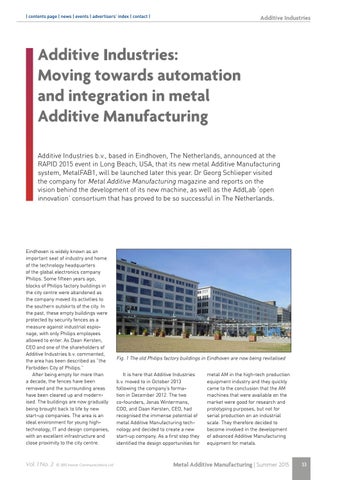| contents page | news | events | advertisers’ index | contact |
Additive Industries
Additive Industries: Moving towards automation and integration in metal Additive Manufacturing Additive Industries b.v., based in Eindhoven, The Netherlands, announced at the RAPID 2015 event in Long Beach, USA, that its new metal Additive Manufacturing system, MetalFAB1, will be launched later this year. Dr Georg Schlieper visited the company for Metal Additive Manufacturing magazine and reports on the vision behind the development of its new machine, as well as the AddLab ‘open innovation’ consortium that has proved to be so successful in The Netherlands.
Eindhoven is widely known as an important seat of industry and home of the technology headquarters of the global electronics company Philips. Some fifteen years ago, blocks of Philips factory buildings in the city centre were abandoned as the company moved its activities to the southern outskirts of the city. In the past, these empty buildings were protected by security fences as a measure against industrial espionage, with only Philips employees allowed to enter. As Daan Kersten, CEO and one of the shareholders of Additive Industries b.v. commented, the area has been described as “the Forbidden City of Philips.” After being empty for more than a decade, the fences have been removed and the surrounding areas have been cleared up and modernised. The buildings are now gradually being brought back to life by new start-up companies. The area is an ideal environment for young hightechnology, IT and design companies, with an excellent infrastructure and close proximity to the city centre.
Vol. 1 No. 2 © 2015 Inovar Communications Ltd
Fig. 1 The old Philips factory buildings in Eindhoven are now being revitalised It is here that Additive Industries b.v. moved to in October 2013 following the company’s formation in December 2012. The two co-founders, Jonas Wintermans, COO, and Daan Kersten, CEO, had recognised the immense potential of metal Additive Manufacturing technology and decided to create a new start-up company. As a first step they identified the design opportunities for
metal AM in the high-tech production equipment industry and they quickly came to the conclusion that the AM machines that were available on the market were good for research and prototyping purposes, but not for serial production on an industrial scale. They therefore decided to become involved in the development of advanced Additive Manufacturing equipment for metals.
Metal Additive Manufacturing | Summer 2015
33
